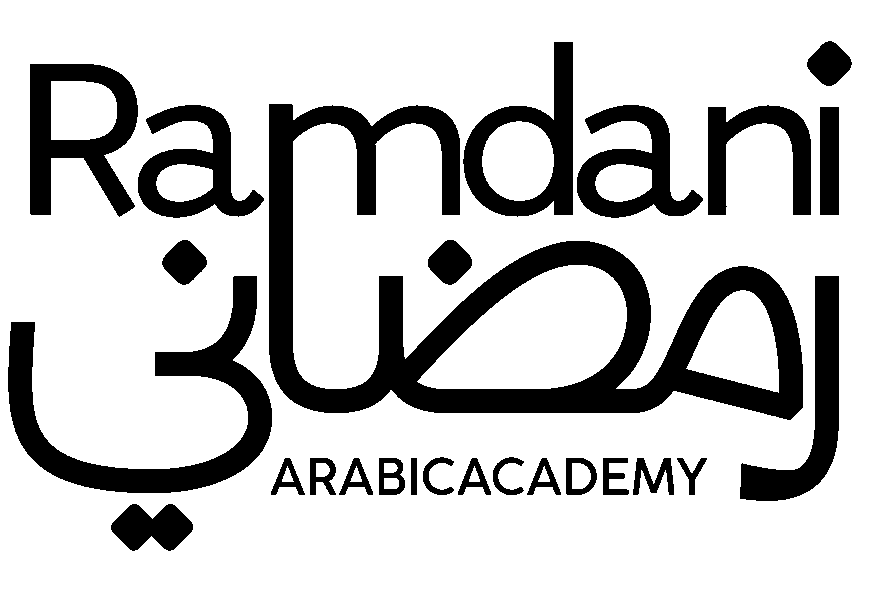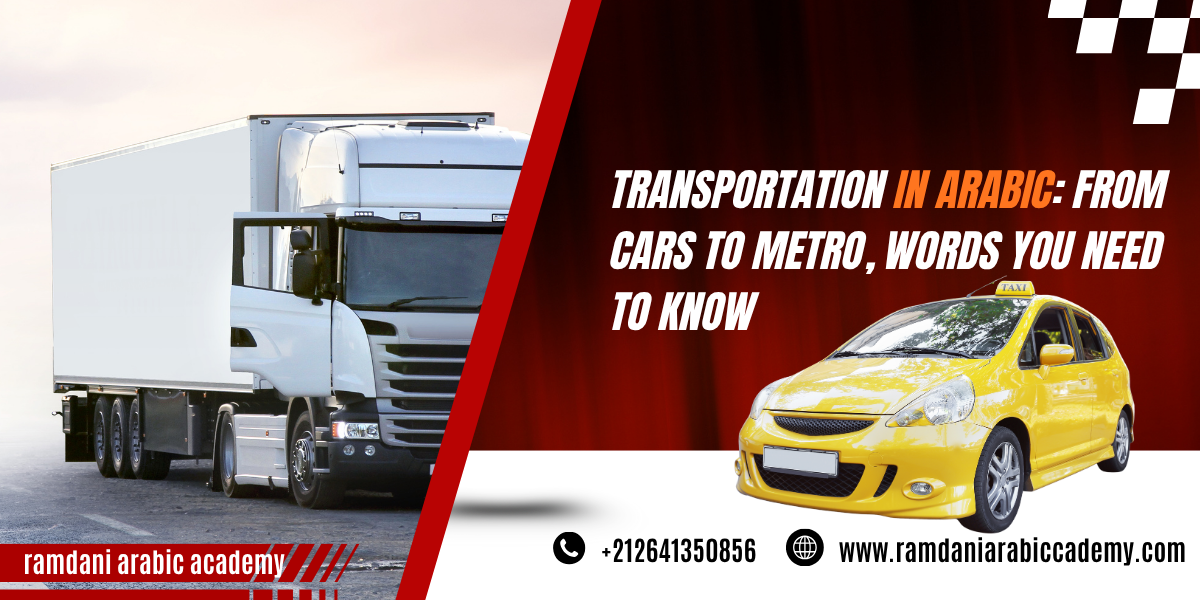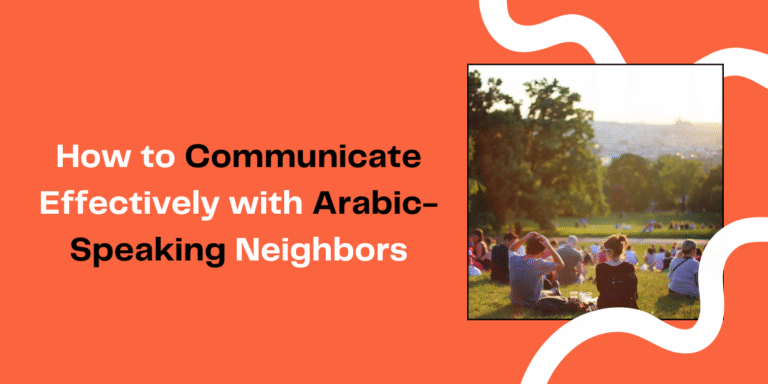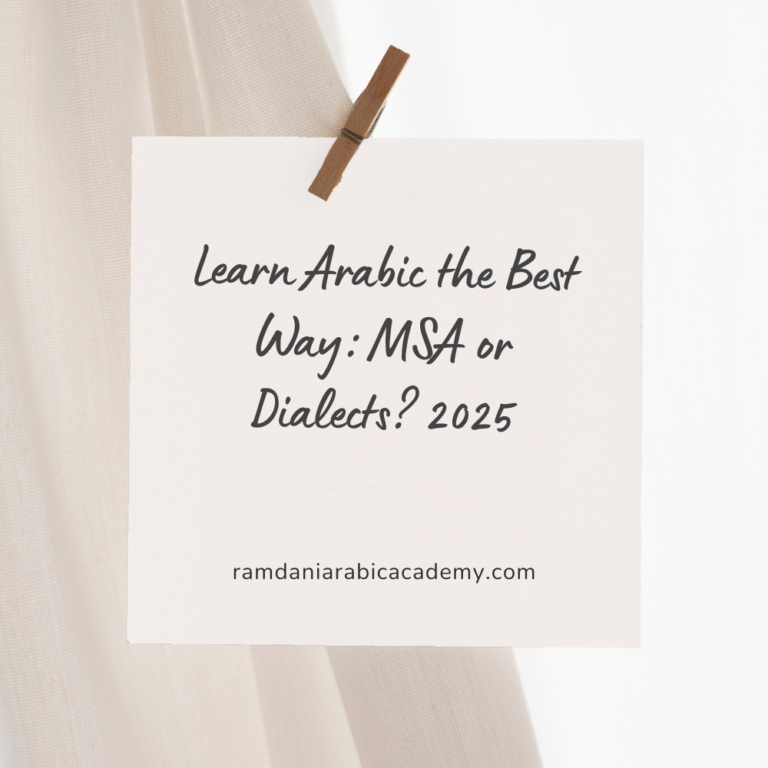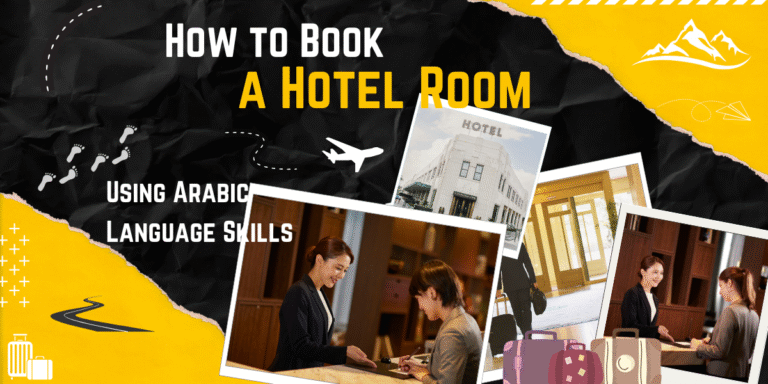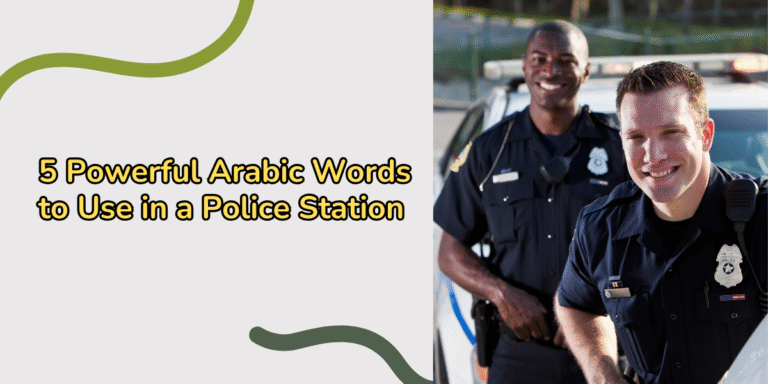Transportation in Arabic: From Cars to Metro 2026
Transportation is one of the first topics that comes up when someone learns a new language. You need words for buses, cars, trains, airports, and the small details that come with them. If you are traveling in an Arab country, you cannot get far without being able to ask for directions, buy a ticket, or understand signs on the road. Even if you are not traveling, transport vocabulary gives you a window into how people live, work, and move around in Arabic-speaking countries. It is a part of daily life, and that makes it a core part of language learning.
When you study transportation in Arabic, you are not just memorizing lists of words. You are also learning how culture shapes the way people move. For example, in many cities you will hear words for taxis and shared minibuses more often than words for subways or trams. In rural areas, the language of transportation may focus more on animals like donkeys, horses, or camels. These differences remind you that Arabic is spoken across more than twenty countries, and each country has its own habits, systems, and terms. Learning these words opens the door to conversations about everyday life, history, and even technology in the Arab world.
Another reason this topic matters is that transportation vocabulary often overlaps with other areas of learning. When you ask about a bus, you also need numbers to know which line to take. When you buy a train ticket, you need to understand times, dates, and prices. When you talk to a taxi driver, you need phrases for directions, neighborhoods, and landmarks. One topic connects to many others. For a learner, this means that studying transportation gives you practice with grammar, sentence building, and polite expressions as well as vocabulary.
For beginners, words like car, bus, or station may seem simple, but they are powerful tools. They give you confidence when you arrive in a new place and see signs written in Arabic. They allow you to manage basic situations without stress. For advanced learners, transportation vocabulary becomes a way to explore deeper questions. How do Arab cities handle traffic? What new projects are being built, such as metro systems in Cairo, Riyadh, or Doha? How do traditional forms of transport like camels remain part of culture today? These questions show how language connects with society and change.
When you study transportation in Arabic, you are preparing yourself for real interactions. Imagine arriving at an airport in Casablanca or Cairo and being able to read the departure boards. Imagine negotiating with a driver in Amman or Beirut and giving your destination clearly. Imagine talking to locals about traffic in Dubai or the new metro lines in Riyadh. These are not just exercises. They are real situations where the words you learn will shape your experience and your confidence.
This article will guide you step by step. We will look at common words for vehicles, stations, and roads. We will cover phrases for buying tickets, asking directions, and describing travel. We will also show examples from different regions, because the Arabic spoken in Morocco is not the same as Arabic spoken in Egypt or the Gulf. Along the way, you will see how transportation vocabulary connects to grammar, culture, and everyday communication.
By the end, you will have more than a list of words. You will have a set of tools you can use the next time you travel, talk with Arabic speakers, or read about transport systems in the Arab world. Learning about transportation in Arabic is a practical step, and it is also an opening to understanding people, places, and daily life in a deeper way.

Part 1: Vocabulary for Vehicles
Transportation begins with vehicles. These are the tools people use every day to move from one place to another. In Arabic, the vocabulary for vehicles is rich, because it reflects both modern life and traditional ways of moving.
The most common word for car is سَيّارة (sayyārah). You will hear this word in every Arab country. In daily speech, people shorten it to عَرَبيّة (‘arabiyya) in Egypt or طُوموبيل (ṭūmūbīl) in Morocco, borrowed from French. This shows how Arabic adapts to local usage. If you only know the standard word, you will be understood everywhere, but learning the local forms gives you an advantage when speaking with natives.
The word for bus is حافِلة (ḥāfilah) in Modern Standard Arabic, but in everyday conversation most people say أوتوبيس (ūṭūbīs), another borrowing. In cities like Cairo, Casablanca, or Amman, buses are a central part of life. They are often crowded, but they are affordable and connect all neighborhoods. If you are learning Arabic, knowing how to ask أين موقِف الأوتوبيس؟ (Where is the bus stop?) is very useful.
For taxis, the standard term is سَيّارة أُجرة (sayyārat ujrah), but most people simply say تاكسي (tāksī). In the Gulf countries, ride-hailing apps like Uber and Careem have become common, but the word taxi is still widely used. In Morocco, you will hear الطاكسي الكبير (the big taxi) and الطاكسي الصغير (the small taxi), two different systems of shared and private rides. These examples show how one word in Arabic can open a door to local culture.
Trains are less common in some Arab countries but very important in others. The word is قِطار (qiṭār). Egypt has one of the oldest train networks in the Middle East, and the word qiṭār is used often there. Morocco and Tunisia also have developed train systems. In the Gulf, trains are newer, often linked with metro projects. When you study this word, you can also learn related ones, such as مَحطّة القِطار (train station).
Air travel is part of modern Arabic life. The word for airplane is طائِرة (ṭā’irah), though most people say طيّارة (ṭayyārah) in speech. The airport is مَطَار (maṭār). Air travel connects distant parts of the Arab world. People often travel between Cairo, Dubai, Riyadh, Beirut, and other cities for work or family. If you can understand basic travel phrases in Arabic, you can manage situations at the airport with more ease.
Boats and ships also appear in Arabic vocabulary. The word for boat is قَارِب (qārib), and the word for ship is سَفِينَة (safīnah). These words come up in coastal regions like Lebanon, Morocco, or Oman. They are also important in history. The Quran itself mentions safīnah in the story of Noah. This shows that transportation words connect not only to travel but also to religion and heritage.
Traditional transport is still alive in some places. The word for camel is جَمَل (jamal). For donkey, it is حِمار (ḥimār). For horse, it is حِصان (ḥiṣān). These animals carried people and goods for centuries. Even today, in rural areas of Egypt, Morocco, or Yemen, you may see them used. In some cities, horse-drawn carriages exist as tourist attractions. For learners, these words remind you that Arabic vocabulary spans modern and traditional life together.
When you put this vocabulary into practice, it is useful to learn phrases around it. For example:
- أُريد أن أستَأجِر سَيّارة (I want to rent a car)
- متى يَرحَل القِطار؟ (When does the train leave?)
- كَم سِعر التاكسي إلى المَطار؟ (How much is the taxi to the airport?)
These examples show how transportation words combine with verbs and grammar. They are not just labels for objects. They are part of living sentences you can use.
As you study, you may notice that Arabic often has a formal version and a local version for vehicles. For learners, this can be a challenge, but also an opportunity. If you focus only on Modern Standard Arabic, you will be understood, but if you add local forms, you will connect faster with people. Saying sayyārah works everywhere, but saying ‘arabiyya in Cairo makes you sound more natural. This balance is key in learning Arabic for real life.
Vehicles are the foundation of transportation vocabulary. They let you talk about how people move, what they drive, and how they travel. Once you master this part, you are ready to go deeper into stations, roads, tickets, and directions, which will be the focus of the next section.
Part 2: Vocabulary for Stations, Roads, and Directions
After learning the names of vehicles, the next step is to understand where they go and how people use them. Words for stations, roads, and directions are essential for real communication. Without them, you can know the word for a car or bus but not know how to explain where you want to go.
The basic word for station is مَحطّة (maḥaṭṭah). This word applies to many types of transport. مَحطّة القِطار means train station. مَحطّة الحافِلة means bus station. مَحطّة البَنزين means gas station. Learning maḥaṭṭah is important because you will see and hear it in many situations.
For road, the standard term is طَريق (ṭarīq). This word can mean both road and way. You may hear phrases like الطَريق السَريع (the highway) or الطَريق الرَئيسي (the main road). In cities, another common word is شارِع (shāriʿ), meaning street. If you are in Cairo and ask في أي شارِع؟ (On which street?), you are using one of the most frequent words in Arabic daily life.
To ask for directions, learners need certain key words. Right is يَمين (yamīn). Left is يَسار (yasār) or in some dialects شِمال (shimāl). Straight ahead is عَلى طول (ʿalā ṭūl) in Egyptian Arabic or دُغري (dughrī) in Levantine. These are not only vocabulary items but survival tools when navigating a new place. Imagine asking a shopkeeper أين المَحطّة؟ (Where is the station?) and receiving the answer خُذ يَمين وبَعدين دُغري (Take a right and then straight ahead). Without these words, it is hard to follow.
Another useful group of words relates to stops and crossings. مَوقِف (mawqif) means stop or stand, often for buses or taxis. إشارة (ishārah) means traffic light or signal. جِسر (jisr) means bridge, and نَفق (nafaq) means tunnel. These terms help when giving or receiving directions. For example, قِف عند الإشارة (Stop at the light) or المَكتبة بَعد الجِسر (The library is after the bridge).
Time and place also matter in transportation. Words like قُرب (near), بَعيد (far), and وَراء (behind) appear often in directions. A local might say المَطعم قُرب المَحطّة (The restaurant is near the station) or البنك وَراء الفُندق (The bank is behind the hotel). Practicing these small but powerful words helps learners build confidence.
As in the vehicle vocabulary, you will see differences between formal Arabic and spoken dialects. While maḥaṭṭah is standard, in Morocco people also use الطّرمواي (ṭramwāy) for the tram stop, from French. In the Gulf, you may hear English loanwords like “station” in casual talk. Learners benefit from knowing the standard first, then picking up local terms depending on the country.
Here are some example sentences that combine stations, roads, and directions:
- أين مَحطّة القِطار؟ (Where is the train station?)
- المَكتبة في شارِع النيل. (The library is on Nile Street.)
- إذهَب يَمين عِند المَوقِف. (Go right at the stop.)
- هَل هذا الطَريق إلى المَطار؟ (Is this the road to the airport?)
These are practical, short phrases that a learner can use immediately. They also show how a small set of words unlocks many possibilities for communication.
Learning vocabulary for stations, roads, and directions is not just about travel. It is also about orientation, building confidence in moving around, and connecting with locals. When you know how to ask for a street or understand a traffic sign, you show respect for the language and culture. It makes your travel smoother and your conversations richer.
In the next section, we will look at vocabulary for tickets, schedules, and travel costs, which are central to using transportation effectively in the Arab world.
Part 3: Tickets, Schedules, and Travel Costs
After vehicles and directions, the next challenge in transportation is dealing with tickets, schedules, and prices. These elements are part of every trip. If you know how to ask for a ticket, check the time, and confirm the cost, you can travel with confidence.
The word for ticket is تَذكِرة (tadhkirah). This applies to buses, trains, planes, and even events. In daily speech, people often shorten it to تَذكرة (tazkara). You may hear it at bus stations, airports, or cinemas. For example, أُريد تَذكِرة إلى الدار البيضاء (I want a ticket to Casablanca). Simple, direct, and practical.
Schedules are another important part. The word مَوعِد (mawʿid) means appointment or schedule. For transport, you may also see جَدوَل (jadwal), meaning timetable. A train station will post a جَدوَل المَواعيد (schedule of departures). Learners should practice asking متى يَرحَل القِطار؟ (When does the train leave?) or متى الوُصول؟ (When is the arrival?). These questions open doors when traveling.
Prices matter in daily life. The word for price is سِعر (siʿr). A common phrase is كَم السِعر؟ (How much is the price?). In transport, you may also hear الأُجرة (al-ujrah), meaning fare. For example, كَم الأُجرة إلى المَطار؟ (How much is the fare to the airport?). Taxi drivers across the Arab world expect this question. In Morocco, you may hear بشحال؟ (How much?) in dialect, while in Egypt people often say بكام؟ (How much?). These local forms make travel smoother.
Another useful word is حَجز (ḥajz), meaning reservation. This applies to seats, hotels, and tickets. For example, عِندي حَجز باسمي (I have a reservation under my name). At airports or train stations, this is a phrase worth memorizing. It signals that you already arranged your travel.
Learners should also practice numbers, because numbers and tickets go together. Imagine asking for two tickets: تَذكِرتان (tadhkiratān). Or three tickets: ثَلاث تَذاكِر (thalāth tadhākir). Numbers and plurals become practical here, not just grammar exercises.
Here are some useful phrases that combine tickets, schedules, and prices:
- أُريد تَذكِرة ذِهاب وإياب (I want a round-trip ticket).
- متى يَرحَل الباص القادم؟ (When does the next bus leave?).
- هَل القِطار مُتَأخِّر؟ (Is the train delayed?).
- أُريد أن أحجِز مَكاناً في الطائرة. (I want to book a seat on the plane).
These examples show that a small set of words can handle many travel situations. They also give learners confidence, since transport is one of the most common areas where Arabic is needed in real life.
Just like with vehicles and directions, there are differences between formal and spoken Arabic. In Morocco, many transport staff mix French with Arabic, so you may hear “billet” for ticket. In Lebanon, people often use English loanwords like “ticket” or “reservation.” The standard words, however, work across all Arab countries. That is why learners should master the basics first, then add local expressions when needed.
Understanding tickets, schedules, and costs is not just about movement. It is also about independence. When you can manage these conversations in Arabic, you do not have to depend on translation apps or others to help you. You become more active in your learning and more connected to the culture.
In the next section, we will focus on phrases for conversations with drivers and staff, which is where much of this vocabulary becomes truly alive in interaction.

Part 4: Phrases for Conversations with Drivers and Staff
Transportation is not only about vocabulary for vehicles, stations, or tickets. Real life travel also requires talking to drivers, ticket clerks, and staff. These interactions can be short, but they are important. If you know how to ask the right questions politely, you will make your journey easier and smoother.
Politeness is central in Arabic. Simple words like مِن فَضلِك (min faḍlik – please) and شُكراً (shukran – thank you) go a long way. When speaking to a driver or staff member, these expressions make the conversation more natural. For example: تَفَضَّل، مِن فَضلِك، أُريد تَذكِرة (Excuse me, please, I want a ticket). It shows respect and helps you receive better service.
One of the most common needs is asking if a bus or taxi is going to a certain place. A simple phrase is هَل يَذهَب هذا إلى…؟ (Does this go to…?). For example: هَل يَذهَب هذا إلى المَطار؟ (Does this go to the airport?). This structure works for buses, taxis, or minibuses. It is flexible and easy to use.
For taxis, bargaining or confirming the fare is often part of the process. A useful phrase is كَم الأُجرة إلى…؟ (How much is the fare to…?). Once the driver answers, you may agree by saying مُناسِب (munāsib – fair/okay) or you can negotiate. In some countries, like Morocco or Egypt, bargaining is normal. In Gulf countries, taxis usually use meters, so the conversation is shorter.
Another frequent situation is asking about the time. You can say متى يَرحَل؟ (When does it leave?) or متى الوُصول؟ (When is the arrival?). Staff at bus or train stations hear these questions daily. Adding مِن فَضلِك makes the request more polite.
Sometimes you need to explain where you want to stop. On a bus, you can say سَأَنزِل عِند… (I will get off at…). In taxis, you may give a clear address: إلى شارِع النيل، مِن فَضلِك (To Nile Street, please). If you do not know the exact address, landmarks are useful. For example: قُرب الجامِع (Near the mosque) or أمام المَدرسة (In front of the school).
Here are some practical phrases for conversations:
- تَوقّف هنا، مِن فَضلِك. (Stop here, please.)
- هَل هذا المَكان بَعيد؟ (Is this place far?)
- متى الباص القادم؟ (When is the next bus?)
- أُريد مَقعَداً جَنب الشُبّاك. (I want a seat by the window.)
- هَل يُمكِن أن تَنتَظِر دَقيقة؟ (Can you wait a minute?)
These examples prepare learners for everyday contact. The goal is not only to know words but to use them naturally in conversation. Each small interaction builds confidence and skill.
One detail learners should remember is that body language often supports speech in Arabic cultures. Drivers may point with their hand, nod, or repeat the main word. Listening carefully and watching gestures helps you understand faster. For example, if you ask for directions and hear “yameen” while the person points right, you know the meaning instantly.
Regional differences appear here too. In Egypt, drivers may use local forms like فين؟ (Where?). In Morocco, you may hear French mixed in, such as كم le prix؟ (How much is the price?). In the Gulf, English words are common in airports and taxis. Learners should adapt, but starting with the standard Arabic forms ensures you will always be understood.
Conversations with drivers and staff show how language learning meets real life. These exchanges are short but full of meaning. They require basic grammar, politeness, and listening skills. When you master them, you can move freely and independently.
In the next section, we will explore regional variations in transportation vocabulary, which show the diversity of Arabic across different countries.

Part 5: Regional Variations in Transportation Vocabulary
Arabic is spoken in more than twenty countries, and each region has its own habits, influences, and words for transportation. For learners, this variety is both a challenge and an opportunity. The standard forms work everywhere, but learning local expressions helps you connect with people on a deeper level.
In Egypt, the word for car is often عَرَبِيّة (‘arabiyya) instead of سَيّارة (sayyārah). The bus is usually called أوتوبيس (ūṭūbīs). A microbus, a common form of shared transport, is called مَيكروباص (maykrūbās). These words reflect how English and French borrowings mix with Arabic in everyday speech. If you use them in Cairo, people will see you as more familiar with their daily life.
In the Levant region (Lebanon, Syria, Jordan, Palestine), you will hear سيرفيس (service) for a shared taxi. This is very common in cities like Beirut or Amman. It comes from the French word “service” but has become part of daily Arabic. For a bus, people often say باص (bās). For directions, instead of yasār for left, many use شمال (shimāl). These details matter when you want to understand locals quickly.
In Morocco and other North African countries, French has left a strong mark. People often say طوموبيل (ṭūmūbīl) for car, from the French “automobile.” The bus may be called كار (kār) in some places, while the tram is الطرام (ṭram), from “tramway.” For tickets, many Moroccans say بيلّيه (billet) instead of tadhkira. If you travel there, you will notice French mixed with Arabic on signs and in conversations.
In the Gulf region (Saudi Arabia, UAE, Kuwait, Qatar, Oman, Bahrain), English has more influence. At airports, it is common to hear people use “ticket,” “station,” or “bus” in English. Still, the Arabic terms are understood. For example, taxi drivers will know سَيّارة أُجرة but also respond to “taxi.” Learners here need to be ready for a mix of Arabic and English.
Some words are shared but have local meanings. For example, in Morocco, طاكسي صغير (small taxi) is a car that stays inside the city, while طاكسي كبير (big taxi) is a shared car that travels between towns. In Egypt, the same distinction does not exist. In the Levant, the word “service” carries the same idea of shared rides. These regional differences show how one concept takes different shapes depending on the country.
For learners, the best approach is to start with Modern Standard Arabic. Sayyārah for car, qiṭār for train, tadhkira for ticket, maḥaṭṭah for station. These words will be understood everywhere. After that, when you focus on a specific region, add the local forms. If you learn arabiyya in Egypt, ṭūmūbīl in Morocco, or service in Lebanon, you will connect more naturally.
Here are some examples across regions:
- Egypt: فين الميكروباص لمدينة نصر؟ (Where is the microbus to Nasr City?)
- Morocco: بشحال الطاكسي الكبير لمراكش؟ (How much is the big taxi to Marrakech?)
- Lebanon: في سيرفيس عالحمرا؟ (Is there a service taxi to Hamra?)
- Saudi Arabia: وين مَحطّة الباص؟ (Where is the bus station?)
These examples show how each country develops its own transport culture. Learning these variations not only helps you travel, but also teaches you about history and society. French influence in North Africa, English in the Gulf, or local creativity in Egypt all leave their mark on the Arabic language.
Regional variations remind learners that Arabic is not one single block. It is a living language with many voices. Understanding this diversity makes you a better learner and a more flexible communicator.
In the next section, we will look at cultural and social aspects of transportation in the Arab world, such as how people use transport daily, what challenges exist, and what role new projects play.
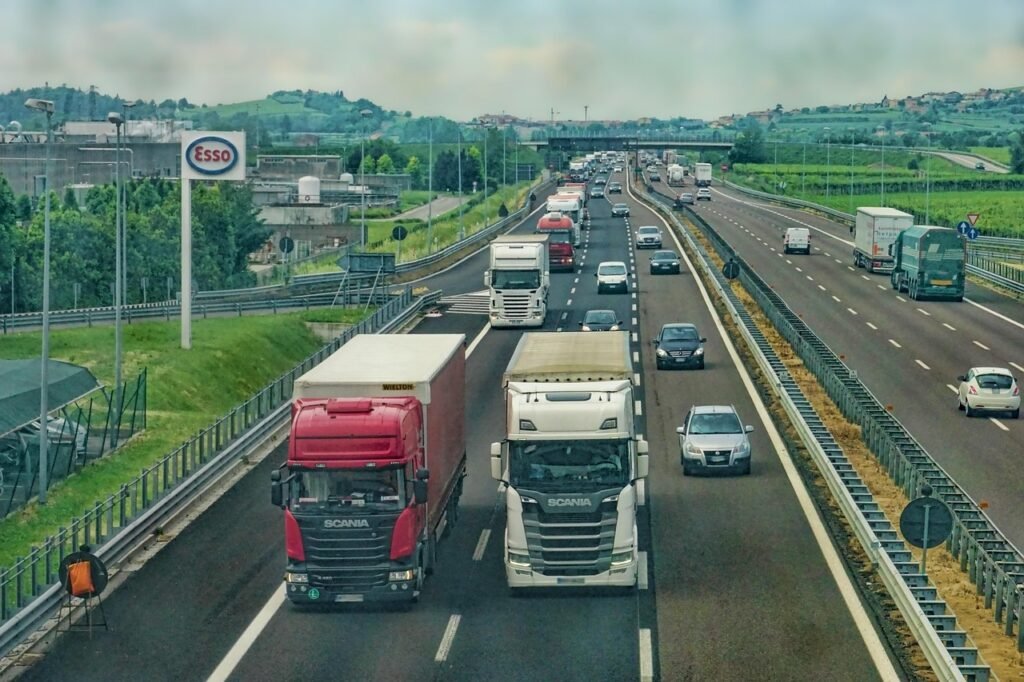
Part 6: Cultural and Social Aspects of Transportation
Transportation in the Arab world is not only about vehicles, stations, and tickets. It also reflects culture, society, and daily routines. When you look closely at how people move in Arab countries, you learn much about their way of life.
In many Arab cities, public transportation is crowded but essential. Cairo is a good example. Millions use buses, minibuses, and the metro every day. The metro is one of the few in the region and has special cars reserved for women. This shows how transport adapts to social needs. In Casablanca and Rabat, the tram has become a symbol of modern development, linking neighborhoods and reducing traffic. In Dubai, the metro is driverless and fully automated, showing a different level of technology and investment.
Outside big cities, shared taxis and minibuses are more common. In Morocco, the “grand taxi” connects towns and villages. In Lebanon, the “service” system lets several passengers share one car, each paying a small fee. These systems are cheaper than private taxis and part of daily life for many people. They also create opportunities for social contact, since passengers talk to each other during the ride.
Social habits influence transportation. In some places, men and women sit separately on buses or trains. In others, seating is mixed. In Saudi Arabia, women once faced limits on driving but today they are free to drive, and this has changed patterns of mobility. In the Gulf, car culture is strong, with wide roads and highways built for fast traffic. In contrast, in old medinas of Morocco or Tunisia, narrow streets are designed for walking, bicycles, or animals rather than cars.
Another cultural aspect is how people talk about transport. Complaints about traffic are common in big cities like Cairo, Amman, or Beirut. Delays, congestion, and crowded vehicles are part of daily conversation. At the same time, new projects such as high-speed trains in Morocco or metros in Riyadh and Doha are points of pride, showing progress and modernity.
Religion and tradition also appear in transport. During the Hajj in Mecca, moving millions of pilgrims safely is a huge challenge. Special buses, trains, and routes are organized for this purpose. In rural areas, camels, donkeys, and horses remain important, especially for carrying goods. These traditional methods coexist with modern cars and trucks, showing a mix of old and new.
Cost is another social factor. Public buses are often the cheapest option, used by workers and students. Taxis are more expensive, but shared rides make them affordable. Air travel connects people across wide distances, especially in countries like Saudi Arabia or Algeria, where cities are far apart. For many families, the choice of transport reflects income and social status.
Learning about transportation in the Arab world gives you more than vocabulary. It helps you understand how people live, what challenges they face, and what changes are happening. It shows you that language is tied to culture in practical ways. When you ask about a bus in Cairo, ride a tram in Casablanca, or take a taxi in Beirut, you are not only moving from place to place. You are also sharing in the daily life of millions of Arabic speakers.
In the next section, we will move to modern developments and future trends in transportation across the Arab world.
Part 7: Modern Developments and Future Trends in Transportation
Transportation in the Arab world is changing quickly. New projects, investments, and technologies are reshaping how people move. For learners of Arabic, knowing the words for these modern systems helps you follow news, read signs, and talk about progress.
One major trend is the rise of metro systems. Dubai’s metro is already one of the most advanced, fully automated and clean. Riyadh is building a large metro network with several lines, planned to reduce traffic and connect the city more efficiently. Doha and Cairo are also expanding their metro systems. The word مِترو (mitrū) is now familiar across the region, even though it is borrowed from English or French.
High-speed trains are another development. Morocco launched the first high-speed train in Africa, called البُراق (al-Burāq). It links Tangier with Casablanca in just over two hours. The word قِطار سَريع (qiṭār sarīʿ) means fast train, and it appears more often in newspapers and announcements. Other countries are considering similar projects.
Airports are also growing. The Arab world has some of the busiest airports globally, such as Dubai International and Hamad International in Qatar. Expansion projects in Jeddah, Muscat, and Abu Dhabi show how air travel continues to connect the region. Words like مَطَار دُوَلي (maṭār duwalī – international airport) or رِحلة مُباشِرة (riḥlah mubāshirah – direct flight) are part of this modern vocabulary.
Sustainability is another theme. Electric buses are being tested in cities like Amman and Cairo. Bike-sharing programs exist in some North African cities. Gulf countries are exploring driverless cars and smart transport systems. Learners may encounter terms like مَرْكَبة كَهرُبائِيّة (markabah kahrubāʾiyya – electric vehicle) or نِظام ذَكي (niẓām dhakī – smart system).
Road projects remain important, especially in large countries. Saudi Arabia, Algeria, and Egypt continue to expand highways to connect distant cities. In the Gulf, long bridges like the King Fahd Causeway between Saudi Arabia and Bahrain symbolize regional integration. These projects show how transportation links economies and societies.
Technology also changes how people use transport. Apps such as Careem and Uber have become common in many cities. Ordering a ride is as simple as pressing a button. The word تَطبيق (taṭbīq – application) is now common in conversations about transport. Learners may hear أُريد سيّارة عَبر التَطبيق (I want a car through the app).
Future trends include more automation, faster trains, and greener transport. For example, the planned نيوم (NEOM) city in Saudi Arabia promotes car-free living, with advanced public systems instead. Other projects in the Gulf aim for electric buses and smart traffic management. These ideas may sound futuristic, but they are already in progress.
For learners of Arabic, modern transport vocabulary shows how language adapts. Traditional words like qiṭār, sayyārah, and maḥaṭṭah remain, but new terms like metro, electric vehicle, and app enter the daily lexicon. Understanding both helps you read the present and talk about the future.
advice, academy mention
Transportation vocabulary in Arabic is more than words. It is a key that opens doors to communication, travel, and understanding daily life in Arab countries. When you learn how to name vehicles, ask for directions, buy tickets, or talk with drivers, you gain skills that work in real situations. These skills give you confidence and independence when you move through Arabic-speaking environments.
For learners, the best advice is to practice transportation vocabulary in context. Do not only memorize lists. Use the words in full sentences. Role-play asking for a ticket, giving an address to a taxi driver, or checking a timetable. Practice numbers, times, and polite phrases together with transport terms. Listen to how locals speak, and notice the difference between standard Arabic and dialects. Each small step adds up to practical fluency.
Another tip is to connect language learning with culture. Transportation shows you how Arab societies function. It teaches you about social habits, economic realities, and modern changes. When you study these words, you are not only preparing for travel. You are also learning about people and their way of life.
At Ramdani Arabic Academy, we focus on teaching Arabic in ways that connect directly to real situations. Transportation is one of the themes we use because it gives learners vocabulary they can apply immediately. Our lessons, courses, and articles aim to make Arabic learning clear, practical, and connected to culture. Whether you are a beginner or advanced learner, our academy helps you move step by step toward your goals.
This article was written by Ramdani Mohamed, founder of Ramdani Arabic Academy. I created the academy to help learners around the world study Arabic with structure and meaning. My goal is to share not only language, but also culture and everyday knowledge that make learning Arabic a rich experience.
Transportation is part of life. By studying it in Arabic, you prepare yourself for real conversations, travel, and deeper cultural understanding.
